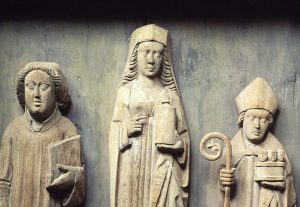Medieval Church Objects and Early Modern Antiquarianism
Postat den 8th November, 2019, 11:13 av Terese Zachrisson
It’s not just the middle ages that can tell us about the middle ages. A very large quantity of medieval devotional objects was preserved – and sometimes in continuous use – in post-reformation churches. The great era of destruction of these artifacts wasn’t in the wake of the Reformation, but occurred during the Enlightenment. By then, medieval churches were considered too small, too dark and too primitive, and the parishes that could afford to do so, often had them torn down and replaced by the spacious, neoclassical white churches that today can be seen all over the Swedish countryside. Sculptures of saints that weren’t lucky enough to have been bought by museums and private collectors, often ended up as oven fuel.

But parallel to, and in part due to, this modernising process, antiquarians and other scholars started to display an increased fascination with the history of their hometowns and villages, resulting in a boom in historical dissertations focusing on the author’s home region. Luckily, this has left an abundance of evidence of many soon-to-be-discarded medieval church objects, whose existence otherwise would have been unknown to us. An excellent example of these 18th-century academic pursuits are the collections of Sven Wilskman (1716–1797) and Olof Sundholm (1752–1819) that I have recently spent a few days researching in Skara stifts- och landsbibliotek as part of the project.
Wilskman and Sundholm systematically collected parish descriptions from the clergy of the Skara diocese, and these descriptions offer many interesting insights into the medieval heritage still kept in parish churches. Though these local pastors had an excellent knowledge of their own churches, as to when renovations had taken place, when an object had been discarded and so on, they weren’t always that knowledgable when it came to iconography.
In the description of Ottravad parish church, authored by its vicar in 1784, the vicar tells us of an image of a man placed in a shrine in the church. According to his parishioners, the image represented a man named Antonius, who had once lived in the parish. He was a prosperous swine farmer, and used all the revenue from his sale of pork to pay for the foundation of Ottravad church. That was why he was shown with a pig on his arm, with a small bell around its neck. Though the vicar himself didn’t know it, this description helps us to identify the saint as the desert father St. Anthony! The people of Ottravad had remembered his name, but without the ecclesiastical framework of the pre-reformation Church, his legend had been forgotten, and a new one invented instead – one that placed him firmly on local ground.

Another interesting finding from these collections is the 18th-century discovery of a relic in Habo parish church. In 1716 the church was to be renovated, and the old high altar was torn down. Inside the altar a small urn was discovered. In the urn there was a small bone wrapped in red silk fabric, and next to it a small piece of parchment, whose inscription contained the information that during the episcopacy of Bishop Sigge (1340–1352), a relic of the 11000 virgins that accompanied St. Ursula had been enshrined when consecrating the altar. The relic container itself is today kept at Västergötlands museum, but the informative piece of parchment seems to have been lost. If the vicar hadn’t remembered the occasion when faced with Wilskman’s questionnaire, we would never have known what saint this object was associated with.
The collections are of course mostly consisting of less spectacular– but not less important – information of medieval church objects. We are told of a now-lost sculpture of the Virgin Mary in Vesene parish church, that the bell of Råda church was consecrated in the honour of St John the Baptist, that St. Catherine was depicted on the murals of Böne parish church, that an inscription in Blidsberg parish said that the church was inaugurated during the feast of St. Eric and that a medieval image of St. Sigfrid had been incorporated into the the early modern pulpit at Öttum parish church.
All in all, these collections help us to fill in the gap when the medieval sources themselves are silent and let us in not only on the richness of medieval lived religion, but of its afterlife in the early modern era as well.
Det här inlägget postades den November 8th, 2019, 11:13 och fylls under Early Modern Antiquarianism Post-Reformation Sculpture Skara diocese

